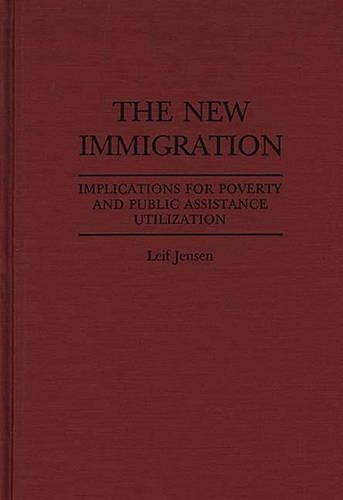
The New Immigration: Implications for Poverty and Public Assistance Utilization
(Hardback)
Publishing Details
The New Immigration: Implications for Poverty and Public Assistance Utilization
By (Author) Leif Jensen
Bloomsbury Publishing PLC
Praeger Publishers Inc
24th March 1989
United States
Classifications
Tertiary Education
Non Fiction
Social welfare, social policy and social services
362.8400973
Physical Properties
Hardback
219
Description
Lofty sentiments notwithstanding, the United States has consistently sought to exclude impoverished immigrants from entering the country on the grounds that many become dependent on social welfare institutions. Leif Jensen thoroughly explores the nature of poverty and public assistance utilization among immigrants to the United States during the years 1960 to 1980. Among the questions he explores are: Has there been an increase in the level of poverty and the degree of public assistance utilized by immigrants to the United States during the past twenty years How do these levels compare to those for native-born Americans and across key racial and ethnic groups How do individual and family characteristics affect the propensity of families to be poor or to receive public assistance Following an introduction to the study as a whole, Jensen presents theoretical issues that bear on differences in poverty and welfare use. He reviews U.S. immigration history with particular emphasis on those aspects that are relevant to poverty and the receipt of public assistance. The chapters that follow review methodological issues, then present the results of Jensen's empirical analysis; two chapters focus on poverty at the family level and two consider public assistance utilization. These chapters build a conceptual background for a multivariate model of poverty at the family level. Because the mere propensity to receive public assistance is only one aspect of the welfare burden imposed by a particular group, the author also examines the absolute amount of public assistance received. Finally, he synthesizes the key findings of his empirical analysis, drawing conclusions regarding the pervasiveness of poverty and actual public assistance receipt among new immigrants. Jensen's thorough analysis and provocative conclusions make this book essential reading for those interested in sociology, demography, economics, and political science.
Reviews
." . . The New Immigration focuses on recent immigrants and patterns of welfare use, addressing popular fears that recent, predominantly Asian and Hispanic immigrants are welfare prone and swelling the ranks of the urban underclass. . . . [T]his book is an excellent reference on the topic of immigration and welfare use that, if heeded, would introduce a note of reason into the ideologically charged immigration-restriction debate."-American Journal of Sociology
. . . The New Immigration focuses on recent immigrants and patterns of welfare use, addressing popular fears that recent, predominantly Asian and Hispanic immigrants are welfare prone and swelling the ranks of the urban underclass. . . . [T]his book is an excellent reference on the topic of immigration and welfare use that, if heeded, would introduce a note of reason into the ideologically charged immigration-restriction debate.-American Journal of Sociology
Basing his study on US Census data from 1960 to 1980, Jensen asks, then answers (using descriptive and multivariate analyses), four questions: Has there been an increase in the level of poverty and degree of public assistance utilization among immigrants over the past 20 years How do these levels compare to those for the native born How are these levels patterned across key race/nativity groups How do individual/family characteristics interact with nativity in affecting the chance of families to be poor or to receive public assistance There is a wealth of information here. . . . Upper-division undergraduates and above.-Choice
"Basing his study on US Census data from 1960 to 1980, Jensen asks, then answers (using descriptive and multivariate analyses), four questions: Has there been an increase in the level of poverty and degree of public assistance utilization among immigrants over the past 20 years How do these levels compare to those for the native born How are these levels patterned across key race/nativity groups How do individual/family characteristics interact with nativity in affecting the chance of families to be poor or to receive public assistance There is a wealth of information here. . . . Upper-division undergraduates and above."-Choice
Author Bio
LEIF JENSEN is Assistant Professor of Sociology and Anthropology at Bates College in Lewiston, Maine. He has contributed articles to the Sociological Inquiry, Policy Studies Journal, and the International Migration Review, and two chapters to Divided Opportunites: Minorities, Poverty and Social Policy.
